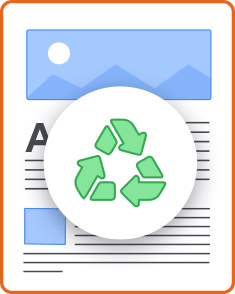When it comes to burnishing your brand by providing users with answers to specific questions in the vastness of the World Wide Web, content marketing has a big impact. This approach focuses on the creation and dissemination of valuable and consistent content with the goals of

convincing your target audience of the value of your service offering,

finding new customers, and

retaining existing ones.
Today, content marketing is – at least for most companies – an integral part of the marketing strategy and can no longer be dismissed as an entertaining trend. Whether by storytelling, through a blog post, an infographic or a white paper – the key is to offer added value. Good content marketing awakens positive associations with one’s own brand and increases its awareness in the long run.
The decisive advantage: It costs significantly less than classic marketing but can generate three times as many leads. In addition, for the majority of users, it is the preferred way to find out about a company. Seventy percent of people would rather learn something from an article than an advertisement.

Aside from the fact that they do not seem to be receptive to intrusive messages, many users have moved on from traditional ads. Instead, they rely on serious content – transported via websites, reviews and well-known people.
Eighty-seven per cent of UK marketers use content marketing. Studies also show that a strong commitment to content marketing often results in higher overall success.

Useful content is the centrepiece of marketing
Target group-oriented content that informs, advises and entertains or inspires is indispensable to the minds of decision-makers and marketers. Understand this, and it’s easy to understand how content marketing is one of the favourite marketing methods within digital communication, and rightly so. By providing Internet users with valuable content at every stage of their journey and meeting their needs, companies are gaining new customers – and building the loyalty of existing ones. After all, whoever finds the answers to their initial questions on page one is likely to return. Loyalty is built well before the purchase. The customer researches, plans and discovers before making a purchase. Market giants like Amazon and Google understand how customer loyalty works. It is not by chance that their influence is immense, and their consumer confidence is accordingly high – especially when it comes to buying decisions.
History in Content Marketing: In 1968, Weight Watchers Magazine was founded, becoming one of the first consumer magazines to be distributed via newsstands and at supermarkets. Nowadays, as well as their print magazine, their website and thus support customer loyalty. Many other companies, such as Betty Crocker, are also successful with this strategy. For your content to perform well, you must place your target group at the centre of attention – use topics that inspire them along the customer journey. This is particularly true in B2B, where everything revolves around the buying process; successful content marketing pays off.
Are you still searching for the right content for your marketing strategy?
Find suitable authors at Textbroker.
The content marketing credo
Where is content marketing involved, and in which areas is high-quality content required?
In a nutshell: Well-functioning content marketing delivers useful, high-quality information that users are looking for and, of course, want to find intuitively. Companies should engage their customers with compelling content, rather than boring them with exchangeable advertising messages.
Which key figures are used?
When content is perfectly tailored to the needs of the target audience, it strengthens identification with the brand and appears in different formats and on different channels. The focus is on a positive user experience. The prerequisite for this is the company must be prepared to deal intensively with its target group, to constantly learn from it and utilise up-to-date technologies for its content marketing.
Content marketing strategy: Give instead of take
A well-developed content strategy is built for the long-term with campaigns that build on one another. These campaigns should, of course, be executed across all departments keeping the following in mind:
A marketing strategy can only be successful if, in addition to excellent industry and market knowledge, it builds on a good understanding of the target group. You give valuable information to your potential buyers and express your appreciation to them – regardless of whether they ultimately become customers or not.
It’s best to plan your actions across channels. You want to reach the customers of today and tomorrow with content featured on your website, your online shop, blog, app and on various social media platforms. At the centre is an emotionally effective story. It is also important to consider all steps of the sales funnel and to provide the customers with appropriate content at every stage of their purchase decision.
The entire content creation process consists of the following stages:

Analysis

Conception and planning

Production

Distribution

Evaluation
A linguistic digression: Google wants to understand language at all levels.
If one thinks of the possibility of human-machine communication, the following fact is interesting: Content today must be designed in such a way that it works equally well for users (humans) as well as for Google and other search engines. Of course, content should be designed so it can be processed by both sides. This applies both to the syntax and the areas of semantics and pragmatics. Semantics is all about the meaning of content, whereas pragmatics deals with concrete communication situations. Here, the respective context takes centre stage. This is dependent on human action and it is important to understand even non-literal meanings, such as ironic remarks.
Google actively tries to counter web spamming, and they get better at that each year. As a result, web content must offer real value and be primarily relevant to the user nowadays. White Hat SEO is becoming more important in this context. This is reflected in Google’s updates. The evaluation of content is no longer limited to the syntactic level. There are also semantic and pragmatic factors playing a much more important role. The search engines are faced with a major challenge: not only must they offer correct information, they must also consider emotional values. So, it is more important to understand the user with all their personal and cultural specifics, to address them correctly with the right choice of words, to convey emotions and – for example by good calls-to-action – to trigger the desired results. To put it in a nutshell: Content must be able to trigger. The progress of search engines, one could say, is accompanied by a profound understanding of linguistics.
Are you still looking for content that addresses your users accurately?
Let our authors help you!
Arouse emotions and positively influence the purchase decision
It is no longer a secret that users’ search and click behavior can be measured down to the last detail. The success of any piece of content can be evaluated using crucial signals such as the bounce rate or the click-through rate.
Content can activate curiosity and certain actions on the part of users and should be designed with the user’s emotions in mind. What does this mean for the writing process and your search for the right author?
To summarise it:
Target group orientation:
What interests your target group? This is a question companies should ask first when planning and creating content. Only content that is really relevant to your own target audience can contribute to the achievement of your business goals.
High content quality:
Well-written and well-prepared articles testify to the competence of a company. It goes without saying that all content should be structured, error-free and reader-friendly.
Unique Content:
Only with unique articles companies can reach a top search engine position. Google penalises pages with copied and less user-relevant content.
SEO:
Successful online content is not only targeted, unique and well written. It is also search engine optimised – for example, with matching keywords, subheadings, a clear structure and meaningful links.

In doing so, you can not only pick up your users emotionally via appealing pictures and atmospheric graphics or sounds, but also steer them through structured content that consciously and skillfully uses the following:
Empathy:
This is about the feeling of being understood, so that not only the content personas are “served” schematically, but the needs of the user should actually and comprehensively be understood.
You Must Know the Problem Before You Can Find the Solution
The problem must be specifically addressed in order to then be able to steer towards the solution. A specifically formulated need results in a specifically formulated solution for the respective problem. Popular marketing tools that credibly present the solutions are white papers or case studies in this context.
Solution:
It must be easy to understand and should not only be the answer to the question or the problem, but also communicate your brand and product.
Testimonial:
To emphasise the seriousness of the solution and its success in practice, customer reviews or seals of approval are worth gold. They create trust – and show that the investment is worthwhile and needs are met. Also question-answer games and expert interviews can be effective here.

Content marketing in practice and for the future
As soon as the interest of the potential customer has been awakened, it is important to do everything you can to keep them loyal. Content marketing has a particularly sustainable effect: high-quality content entices the user to read on, look ahead, continue to click. Once the website has been filled with good content, it can generate traffic for months and years. Google also prefers good content, which ultimately reflects in the search results. When it comes to the selection of topics, the products and services come first, followed by customer mentions, corporate values and innovations.
According to a study by the renowned Content Marketing Institute, almost all – in fact 90 percent – of B2B marketers give informational content that meets the needs of their target group and takes priority over sales and advertising messages. Of course, more money was spent on creating such valuable content.

The demand for videos is also increasing. Not only are large companies such as GE and John Deere are focusing on marketing with good content, but also an increasing number of small- and medium-sized businesses are exploring the possibilities of the Web for efficient content marketing. Today, communication channels are more diverse than ever, and the range of a publication is almost unlimited. In addition, it is cheaper than ever for companies to publish their own content. Many companies run their own blog, publish white papers, e-books and infographics, or produce videos to clarify their expertise. As varied as the forms of publication, there are also various types of content the companies publish: Online stores offer their target groups purchase advice, managers comment on current industry developments in the corporate blog and manufacturers use branded articles and e-books to give tips on the optimal application possibilities of their products.
Facebook is both a critical and versatile network. After all, there are about 39.2 million monthly active users on this platform in the UK alone, from Generation Z to Silver Surfers, and the user base is expected to continue growing.
Almost all companies use Facebook to connect with their target groups. According to a Hootsuite survey of 9,000 B2B and B2C organisations, 97% said they use Facebook as their top platform. Where content is consumed depends on the age of the persona.
In the future, language searches could become a big topic. Basically, digital transmissions and multimedia content are becoming increasingly popular. Videos remain the # 1 most used content format. They also get the most attention, especially among younger users. Infographics are even more popular than pictures.
Mobile First:
Likewise, users demand mobile-optimised content formats and fast mobile websites for use on smartphones, their constant companion. In addition, a fast response time in dialogue with customers is becoming more important, and messenger marketing via WhatsApp or Facebook is also on the rise.
Evergreen Content:
Many companies today also focus on evergreen content. In any case, it pays off to give the existing content a fresh look from time to time and to regularly optimise the content.

Your marketing timetable
Content marketing, which precisely recognises the users’ worries and needs and skilfully responds, pays sustained attention to brand awareness and popularity as well as customer loyalty. The more specific the content is and the more captivating the stories it integrates, the more content marketing helps retain customers for your business. Consistency and a holistic approach are two key factors in content production. You must always keep in mind that you should focus on the topic and not the respective channel. The corporate website or blog represents in this context the content hub. As quality plays an increasingly important role, you should never forget your metrics. Another criterion for the success of your content-marketing strategy is a cross-departmental implementation. Many companies lack the necessary resources or the required writing skills for implementation. Here, it makes sense to outsource the content creation and rely on experienced copywriters in the respective field.
Are you still looking for content thataddresses your users accurately?
Let our authors help you!







No comments available